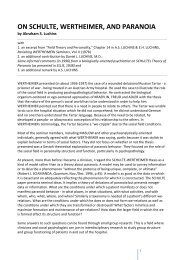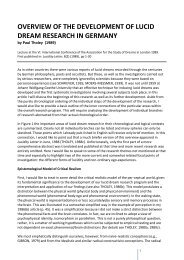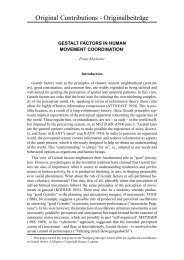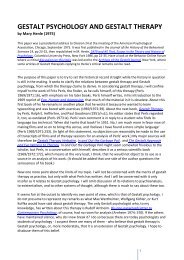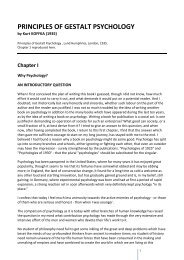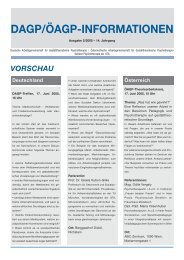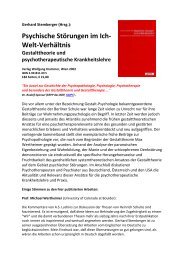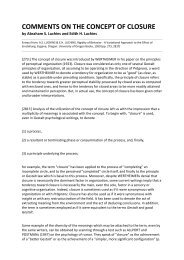pdf-Download - Society for Gestalt Theory and its Applications (GTA)
pdf-Download - Society for Gestalt Theory and its Applications (GTA)
pdf-Download - Society for Gestalt Theory and its Applications (GTA)
You also want an ePaper? Increase the reach of your titles
YUMPU automatically turns print PDFs into web optimized ePapers that Google loves.
For the <strong>Gestalt</strong>ists the total field, in the widest sense, consists of the geographic environment <strong>and</strong> the psycho-physicalorganism within it. Only a portion of this field is psychologically represented; this is the phenomenal (or psychological)field of direct experience or awareness. It includes distal representation <strong>and</strong> the phenomenal self. The behaviouralenvironment, or life space, is more inclusive than the phenomenal field, <strong>and</strong> extends beyond momentary awareness.In turn, the behavioural environment corresponds only to that segment of the wide geographic environment thataffects behaviour. (Ibid., p.100)SCHEERER also pointed to some gaps in <strong>Gestalt</strong> psychological research:The <strong>Gestalt</strong>ists have not attempted to deal with the acquisition <strong>and</strong> function of symbols, concepts, ideationalcontents, <strong>and</strong> language, nor with the manner in which these are reflected in the phenomenal field <strong>and</strong> in motivatedbehaviour. KOFFKA acknowledges this gap. (Ibid., p. 113).SCHEERER cited KOFFKA's comments (1935, p. 422) on the importance of not only the palpablypresented behavioural environment but also the environment which we "merely" imagine or thinkof, an environment closely related to our language. Recognizing that "an ultimate explanation ofthe problems of thought <strong>and</strong> imagination will not be possible without a theory of language <strong>and</strong>other symbolic functions," KOFFKA admitted that "we shall exclude the study of language from ourtreatise," rather than risk a superficial treatment (1935, p. 422).SCHEERER also pointed to an additional gap in <strong>Gestalt</strong> psychological research:Another admitted gap is the social <strong>and</strong> value-oriented aspect of behaviour. Ef<strong>for</strong>ts have been made to implement<strong>Gestalt</strong> theory in this direction. With regard to value, KÖHLER (1938) has presented a novel approach of combining thephenomenological analysis of "requiredness" with the <strong>for</strong>mal principles of isomorphism. ASCH (1952) has extendedthe <strong>Gestalt</strong> approach with the cognitive aspect of human interaction. However, in these later ef<strong>for</strong>ts, symbolicbehaviour <strong>and</strong> <strong>its</strong> relation to motivation are secondary. (SCHEERER, 1954, p. 115)The gaps that KOFFKA acknowledged in 1935 decreased in subsequent years. KÖHLER's 1938 bookon value was acknowledged by SCHEERER. In the 1937-1938 seminars, WERTHEIMER dealt withthe environment that one imagines <strong>and</strong> thinks of, as well as with emotions <strong>and</strong> with language <strong>and</strong>symbols. He provided lively demonstrations using colors <strong>and</strong> music <strong>and</strong> suggested experimentaloutgrowths. One of the most popular courses WERTHEIMER taught at the New School was onmusic <strong>and</strong> art. Some of his students undertook research in these areas. Among them was RudolfARNHEIM, who did a doctoral dissertation on expressive movement under WERTHEIMER, <strong>and</strong> whotogether with students did research on perception <strong>and</strong> art, resulting in his 1969 book to which weturn.ARNHEIM: ART AND PERCEPTIONIn Art <strong>and</strong> Visual Perception: A Psychology of the Creative Eye, Rudolf ARNHEIM (1969)acknowledged his indebtedness to <strong>Gestalt</strong> psychology <strong>and</strong> <strong>its</strong> founders:The experiments I am citing <strong>and</strong> the principles of my psychological thinking derive largely from gestalt theory. Thispreference seems justifiable. Even psychologists who have certain quarrels with gestalt theory are willing to admitthat the foundation of our present knowledge of visual perception has been laid in the laboratories of that school. Butthis is not all. From <strong>its</strong> beginning <strong>and</strong> throughout <strong>its</strong> development during the last half century, gestalt psychology hasshown a kinship to art. The writings of Max WERTHEIMER, Wolfgang KÖHLER, Kurt KOFFKA are pervaded by it. Here<strong>and</strong> there in these writings the arts are explicitly mentioned, but what counts more is that the spirit underlying thereasoning of these men makes the artist feel at home. In fact, something like an artistic look at reality was needed toremind scientists that most phenomena of nature are not described adequately if they are analyzed piece by piece.The realization that a whole cannot be attained by adding up isolated parts was not new to the artist. (p. vii)Concerned with dynamic patterns, <strong>and</strong> raising the question of what was meant by perceptual<strong>for</strong>ces, ARNHEIM wrote:Throughout this book it must be kept in mind that every visual pattern is dynamic. Just as a living organism cannot bedescribed by <strong>its</strong> anatomy, so the essence of a visual experience cannot be expressed by ...static measurements [which]9



